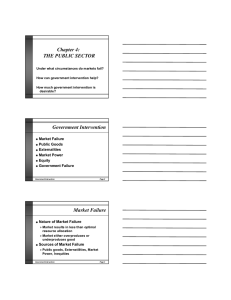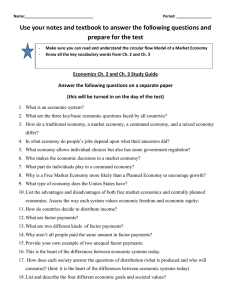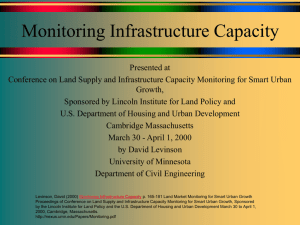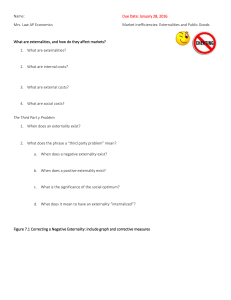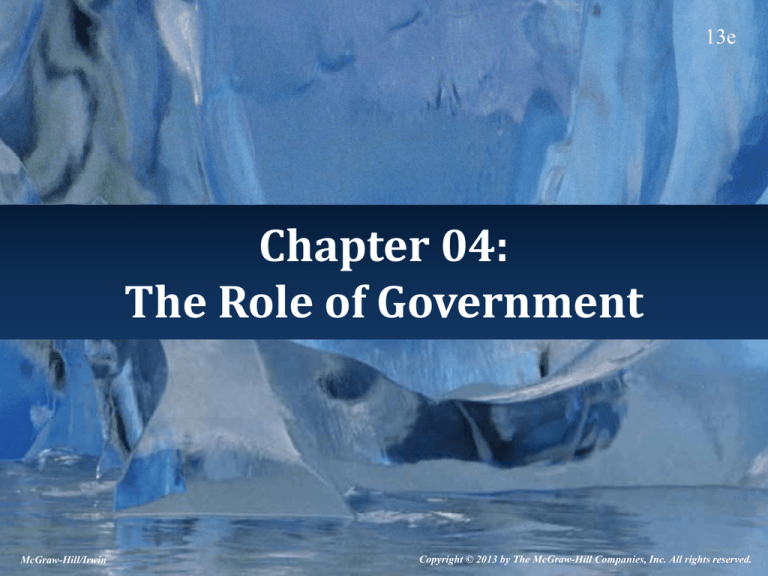
13e
Chapter 04:
The Role of Government
McGraw-Hill/Irwin
Copyright © 2013 by The McGraw-Hill Companies, Inc. All rights reserved.
Learning Objectives
• 04-01. Know the nature and causes of
market failure.
• 04-02. Know how the public sector has
grown.
• 04-03. Know which taxes finance state,
local, and federal governments.
• 04-04. Know the meaning of government
failure.
4-2
Society’s Goal
• To produce an optimal
mix of output.
• Optimal mix of output:
the most desirable
combination of output
attainable using
existing resources,
technology, and social
values.
4-3
Market Failure
• Society wants the
combination at point X.
• The market mechanism
would lead us to point
M.
• Market failure: an
imperfection in the
market mechanism that
prevents optimal
outcomes.
4-4
Market Failure
• Market failure implies that the market mechanism
did not lead us to the optimal point on the PPC.
• Market failure establishes a basis for government
intervention.
• Specific sources of market failure are
–
–
–
–
Public goods.
Externalities.
Market power.
Inequity.
4-5
Public Goods
• Private good: a good or service whose
consumption by one person excludes
consumption by others.
– A doughnut.
• Public good: a good or service whose
consumption by one person does not
exclude consumption by others.
– National defense.
4-6
Public Goods
• The free-rider dilemma: the communal
nature of public goods may cause some
consumers to try for a free ride.
• Free rider: an individual who reaps direct
benefits from someone else’s purchase
(consumption) of a public good.
– Rides along “for free” on your market purchase.
4-7
Public Goods
• Everyone waits to use the good “for free.”
• Since there is no apparent buyer of the good,
no producer will bring it to market.
• The market fails to produce a good that
society desires.
4-8
Public Goods
• The market tends to underproduce public
goods, if it produces them at all.
• Government’s role:
– Step in and become the buyer.
– The producer then produces the public good.
– Finance the purchase with taxes or user fees.
4-9
Externalities
• Externalities
– A two-party (buyer and seller) transaction
occurs, but there are costs (or benefits) borne
by a third party.
– The difference between the social and private
costs (benefits) of a market activity.
• When externalities are present, market
prices are not a valid measure of a good’s
value to society.
4-10
Correcting for Externalities
• Positive externality
– Third parties benefit because of
a market transaction.
– Not enough is produced and
sold at price p1 because
society’s benefits are greater
than market benefits.
– Government steps in to
generate benefits for society.
– Government action causes
more to be produced by
subsidizing production or
purchase.
– Product is sold at price p3.
– Examples: public education and
inoculations.
Price of
inoculations
D2
S
D1
p2
p1
Subsidy
p3
Market
output
q1
q2
Optimal output
Quantity of
inoculations
4-11
Correcting for Externalities
• Negative externality
– Third parties are hurt (suffer a
cost) because of a market
transaction.
– Too much is produced and sold
at price p1 because society’s
costs are greater than market
costs.
– Government steps in to shift
costs from society to the
producer and the buyer.
– Rising costs cause the supply
curve to shift left.
– Government action causes less to
be produced and sold at a higher
price p2.
– Example: pollution.
Price of
polluting good D
S2
S1
p2
p1
Optimal
output
q2
q1
Quantity
Market output
4-12
Summary: Externalities
• Positive externality
– Society’s benefit > market benefit.
– The market underproduces.
– The government subsidizes to shift demand right.
• Negative externality
– Society’s cost > market cost.
– The market overproduces.
– The government restricts production to shift supply
left.
4-13
Market Power
• Market power: the ability of a firm to
manipulate the price of a good in the
market.
– Thus, the firm can restrict supply in order to
maximize profits rather than produce society’s
desired mix of output.
• Government role
– Restrict market power.
– Promote more competition.
4-14
Inequity
• Income redistribution:
– Reduces the inequity in incomes.
– Provides a minimum amount of merit goods.
• Merit good: a good society believes everyone is entitled
to some minimal quantity of.
• Government redistributes income using
– A progressive income tax system.
• Collect taxes from income earners.
– Transfer payments.
• Provide payments to individuals for which no current
goods and services are exchanged.
4-15
Macro Instability
• The goal of macro intervention is to foster
economic growth.
– Move out of inefficiency and up on the PPC.
• Reduce unemployment.
– Avoid inflation.
• Stable prices.
– Increase our capacity to produce.
• Economic growth.
• Government uses macroeconomic policies in
an attempt to meet these goals.
4-16
Growth of Government
• When society perceives a problem, it looks
to government to “fix” the problem, which
provides justification for government
intervention in the economy.
• As a result, government has grown over the
last century:
– Over 10 times more employees since 1900.
– A budget 6,000 times larger since 1900.
4-17
Government Finances
• Each level of government (federal, state, and
local) creates a budget of fund inflows and
outflows.
• Inflows (sources of funds).
– Taxes (and fees/user charges).
– Borrowing.
• Outflows (uses of funds).
– Purchases of goods and services.
– Payments for resources used.
– Transfer payments.
4-18
Sources of Government Growth
• Direct expenditures, as a percentage of GDP,
have grown a bit more slowly than the private
sector.
• Most of the growth in federal spending is from
increased transfer payments, which now
account for over half of the spending.
• State and local governments buy much more
output than the federal government and
employ five times as many people.
4-19
Taxation
• Taxes pay for government spending.
• There is a change in the output mix as more
government spending absorbs factors of
production that could be used to produce
consumer goods.
• The opportunity cost of taxation is measured
by the private-sector output sacrificed when
government employs scarce factors of
production.
4-20
Taxation
• The primary function of taxes is to transfer
command over resources (purchasing
power) from the private sector to the public
sector.
4-21
Income Tax
• Income taxes: the largest single source of
government revenue.
• It is a progressive tax system.
– As income rises, the tax rate also rises.
– Compared to those with lower incomes, those
with higher incomes:
• Pay more taxes.
• Pay a greater fraction of their income in taxes.
4-22
Social Security Tax
• It is a regressive tax system.
– As income rises, the tax rate falls.
– Compared to those with lower incomes, those
with higher incomes:
• Pay more taxes.
• But pay a smaller fraction of their income in taxes.
4-23
Other Taxes
• Corporate taxes.
– Usually passed on to the customer in higher
prices.
– It is a progressive tax system to the corporation.
• Excise taxes.
– Imposed on a specific good or service.
– Some are imposed to discourage production
and consumption of these goods.
4-24
Other Taxes
• Property tax.
– A major source of local taxes.
– It is a regressive tax, since poorer people devote a
larger portion of their income to housing costs.
• Sales tax.
– Another major source of local taxes.
– It is also a regressive tax, since poorer people tend
to spend all of their income while richer people do
not.
4-25
Government Failure
• Government
intervention should
move the mix of output
closer to society’s
desired mix.
• Government failure:
government intervention
fails to improve
economic outcomes and
may worsen outcomes.
4-26
Perceptions of Waste
• Public perception is that the government isn’t
producing as many services as it could with the
resources at its disposal.
– This inefficiency pushes the economy inside the
PPC.
• A related question is: are we giving up too
many private-sector goods in order to get those
services?
– Is the opportunity cost too high?
4-27
Valuation of Costs and Benefits
• Additional public-sector activity is desirable
only if the benefits from that activity exceed
its opportunity costs.
– How do we identify the benefits?
– How do we enumerate the costs?
– Whose values should be used to do this?
4-28
Public Choice Theory
• Public choice: a theory of public-sector
behavior emphasizing rational self-interest of
decision-makers and voters.
– Government decision-makers are supposed to serve
the people.
– Many, however, set their own agenda. Some give higher
priority to personal advancement than public welfare.
– Bureaucrats are just as “selfish” (utility
maximizing) as everyone else.
4-29
Public Choice: Benefit-Cost Analysis
• Private-sector.
– Benefits and costs usually
accrue to the same
person.
– Makes it easy to compare
the two and make a
decision.
• Government.
– Benefits and costs usually
accrue to different
groups.
– Makes it more difficult for
the decision maker.
– Politics enter into the
decision.
– The decision maker may
have no stake in the
outcome.
4-30
What Does Society Want Produced?
• Can either the market based or the state-run
system, or a combination of the two, produce
the mix of output desired by society in general?
– A pure market system will not produce adequate
quantities of some goods.
– A pure government system cannot determine the
mix of output desired by buyers and sellers.
– By trial and error, a combination of the two systems
may arrive at the optimal mix of goods produced.
4-31

